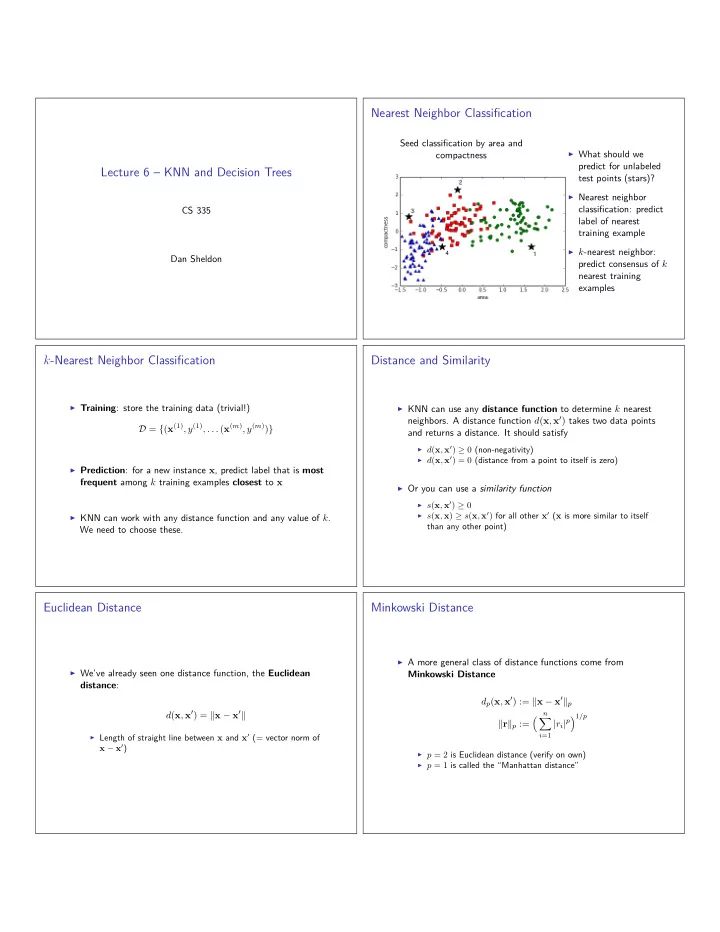

Nearest Neighbor Classification Seed classification by area and ◮ What should we compactness predict for unlabeled Lecture 6 – KNN and Decision Trees test points (stars)? ◮ Nearest neighbor classification: predict CS 335 label of nearest training example ◮ k -nearest neighbor: Dan Sheldon predict consensus of k nearest training examples k -Nearest Neighbor Classification Distance and Similarity ◮ Training : store the training data (trivial!) ◮ KNN can use any distance function to determine k nearest neighbors. A distance function d ( x , x ′ ) takes two data points D = { ( x (1) , y (1) , . . . ( x ( m ) , y ( m ) ) } and returns a distance. It should satisfy ◮ d ( x , x ′ ) ≥ 0 (non-negativity) ◮ d ( x , x ′ ) = 0 (distance from a point to itself is zero) ◮ Prediction : for a new instance x , predict label that is most frequent among k training examples closest to x ◮ Or you can use a similarity function ◮ s ( x , x ′ ) ≥ 0 ◮ s ( x , x ) ≥ s ( x , x ′ ) for all other x ′ ( x is more similar to itself ◮ KNN can work with any distance function and any value of k . than any other point) We need to choose these. Euclidean Distance Minkowski Distance ◮ A more general class of distance functions come from ◮ We’ve already seen one distance function, the Euclidean Minkowski Distance distance : d p ( x , x ′ ) := � x − x ′ � p d ( x , x ′ ) = � x − x ′ � n | r i | p � 1 /p � � � r � p := ◮ Length of straight line between x and x ′ (= vector norm of i =1 x − x ′ ) ◮ p = 2 is Euclidean distance (verify on own) ◮ p = 1 is called the “Manhattan distance”
Examples KNN Implementation ◮ The “brute force” version of KNN is very straightforward: ◮ Given test point x , compute distances d ( i ) := d ( x , x ( i ) ) to each training example ◮ Sort training examples by distance ◮ Jupyter Demo 1: different distance functions ◮ k -nearest neighbors = first k examples in this sorted list. ◮ Now, making the prediction is straightforward. ◮ Running time : O ( m log m ) for one prediction ◮ In practice, clever data structures (e.g., KD-trees) can be constructed to find k nearest neighbors and make predictions more quickly. KNN Trade-Offs Decision Trees ◮ Strengths Example: Flu decision tree ◮ Simple ◮ Converges to the correct decision surface as data goes to infinity Temp%>%100% ◮ Weaknesses F" T" ◮ Lots of variability in the decision surface when amount of data is low ◮ Curse of dimensionality: everything is far from everything else in Sore%Throat%=Y% Runny%Nose=Y% high dimensions ◮ Running time and memory usage: store all training data and F" T" F" T" perform neighbor search for every prediction → use a lot of memory / time ◮ Jupyter Demo 2: KNN in action Healthy% Cold% Other% Flu% ◮ Effect of k ◮ KNN convergence as data goes to infinity Decision Trees Decision Tree Intution ◮ Classical model for making a decision or classfication using “splitting rules” organized into tree data structure ◮ Data instance x is routed from the root to leaf ◮ Board work ◮ Geometric illustration of decision tree: recursive axis-aligned ◮ Nodes = “splitting rules” partitioning ◮ Continuous variables: test if ( x j < c ) or ( x j ≥ c ) (2 branches) ◮ Intuition for how to partition to fit a dataset (= learning a ◮ Discrete variables: test ( x j = 1) , ( x j = 2) , . . . for k possible decision tree) values of x j ( k branches) ◮ x goes down branch corresponding to result of test ◮ Leaf nodes are assigned labels → prediction for x
Decision Tree Learning Decision Tree Learning ◮ How do we fit a decision tree to training data? We won’t give details here, just some intuition. . . Patrons? Type? None Some Full ◮ Idea : recursive splitting of training set French Italian Thai Burger ◮ “Best” splitting rule? Which of these is better? Patrons? Type? ◮ Ideally, split the examples into subsets that are all the same class ◮ Design heuristics based on this principle to choose the best split None Some Full French Italian Thai Burger ◮ When to stop? Recusively split training examples until: ◮ All examples have same class ◮ Start with all training examples at root of tree ◮ Too few data training examples ◮ Find “best” splitting rule at root ◮ Maximum depth exceeded ◮ Recurse on each branch Decision Tree Learning Decision Tree Trade-Offs ◮ Strengths ◮ Interpretability : the learned model is easy to understand ◮ Running time for predictions : shallow trees can be extremely fast classifiers ◮ Weaknessees ◮ Jupyter Demo 3: visualize decision trees to fit to seeds dataset ◮ Running time for learning : finding the optimal trees is computationally intractable (NP-complete), so we need to design greedy heuristics. ◮ Representation : we may need very large trees to accurately model geometry of our problem with axis-aligned splits ◮ General advice: decision trees are very competitive “out-of-the-box” machine learning models for lots of problems!
Recommend
More recommend